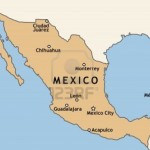In 1888, while Jack the Ripper went about sadistically murdering a number of lower-class London sex workers, halfway across the world in the northern suburbs of Mexico City, a lesser-known man named Francisco Guerrero, a.k.a. “El Chalequero,” was preying upon poor women in a similarly vicious and calculated manner. Few remember Guerrero; his crimes hardly garnered the same attention as the British serial killer’s. Guerrero’s immediate community knew that he had raped and murdered multiple women and yet he roamed free for years before eventually being apprehended by the police. Sexualized violence against women in Mexico has a long history that has been directly tied to state impunity—the lack of proper legal action—and, more recently, to drug cartels and organized crime.
Today, violence in Mexico is often associated with the shocking, public displays of carnage inflicted by warring drug cartels and the controversial steps taken by outgoing President Felipe Calderón Hinojosa to counter their growing influence. However, a silent, gendered war is also being waged against women throughout the country. Women are being raped, strangled, and tortured, their bodies mutilated and discarded in desolate locations, sending a message to Mexican society: Women’s lives are expendable. Their predators will not be punished.
Professor Rosa-Linda Fregoso of the Latin American & Latino Studies Department at University of California, Santa Cruz, explained to WMC’s Women Under Siege: “There is a common, grave mentality that wants to lump all the violence within the war on drugs and not to differentiate. Both kinds of violence are interrelated; violence against women flourishes and proliferates in societies where force and violence are seen as a legitimate response to conflict.” Marusia Lopez Cruz, the Mesoamerica Regional Coordinator of the international women’s rights organization, JASS (Just Associates), told us that one Mexican woman is raped every four minutes—amounting to 120,000 rapes per year.
Gender-based violence in Mexico was once closely associated with Ciudad Juárez (a border town on the Rio Grande River facing El Paso, Texas) shortly following the passage of the North American Trade Agreement (NAFTA) in 1994. Trade barriers had been lowered, factories sprung up, and many rural Mexicans who formerly farmed for a living—including a significant number of women—were forced to migrate to border cities in search of work.
Over the next 20 years, hundreds of women—the Mexican newspaper El Diario estimating close to 900, according to the New Statesman—were tortured, raped, and murdered, their bodies often being discarded in the desert. Initially, many feared a deranged serial killer was responsible, but over time it became apparent that there was no single culprit behind the murders. The term “feminicide” was used to describe these killings—the murder of women and girls because they are female. (The Mexican term “feminicide” differs from “femicide” because the translation of “femicide” in Spanish is simply the killing of females, and does not include the gendered motivation behind the murder.)

Nenetzin Rojastells, an environmentalist from Petatlan in the southwest of Mexico, tells journalists her mother disappeared in December 2011 during a trip to Mexico City for a meeting on peace and security. “Please be brave, mom,” she said. “I know you’re alive. I will never stop negotiating for your freedom.” (Judy Rand)
Violence against women, at the hands of their husbands, family members, or state officials, extends to all states in Mexico, not just Chihuahua, where Ciudad Juárez is located. The level of brutal violence being waged upon Mexican women seems misplaced in a country that is a 1981 signatory of the Convention on the Elimination of All Forms of Discrimination Against Women (CEDAW), which the United States has yet to sign. However, the combination of traditional, narrow gender roles, the growing normalization of violence, and the continued lack of political will and resources from the Mexican government have resulted in an enormous spike in sexualized violence against women.
While it affects women of all classes, gendered violence is higher among certain parts of the Mexican population. As Hector Dominguez-Ruvalcaba, an associate professor in the department of Spanish and Portuguese at the University of Texas, Austin, explained in an interview with WMC’s Women Under Siege: “We have observed gender violence is more prevalent in those communities with a greater presence of criminal organizations, and a greater marginalization: Most of the victims are poor and have little access to education, and other public services like health, street pavements, etc.”
Whether in poor rural villages or amid the hustle of the capital, Mexico City, Mexican women, unable to rely on the government to protect them, are organizing and pushing their communities to stop this epidemic of gender-based violence themselves.
How Sexualized Violence is Used as a Weapon of War
To exert state power: A 2012 report analyzing the effects of violence on women in Mexico, co-produced by the Nobel Women’s Initiative and JASS, found that government officials and their security forces were often the worst perpetrators of sexualized violence and used it as a tool to “intimidate and subdue” women. The 45,000 troops deployed by President Felipe Calderón Hinojosa in 2007 to fight drug cartels contribute to a growing culture of violence and fear, especially for women, youth, indigenous communities, and migrants who are vulnerable in the face of the corrupt and often misogynist security institutions. Francisco González, a professor of Latin American Studies at Johns Hopkins University’s School of Advanced International Studies in Washington, argues in a 2011 Current History article: “It is not far-fetched to say that the average Mexican citizen lives in fear of both criminals and public authorities.”
To silence activists: President-elect Enrique Peña Nieto was governor of the State of Mexico in 2006 when protests against the building of a new airport in San Salvador Atenco erupted into violence. Two protesters were killed and 26 women were sexually assaulted by state and federal authorities. Lulú Barrera, the president of the steering committee for Amnesty International, Mexico, said she believes the assaults were a “tool to demonstrate political control and power” and to deliver a clear, threatening message to other protesters. As of this publication, not a single police officer has been found guilty of assaults. When recently confronted by college students in Mexico City about the lack of justice surrounding the incidents, Peña Nieto was unapologetic and argued that he had used necessary force to restore public order.
To make money: Increasingly, women are being used by drug cartels to transport drugs and fulfill logistical roles. However, Mexican crime groups also earn huge profits in the prostitution industry and have forcibly kidnapped women to traffic them across the border into the U.S. “It’s the third most profitable market after drugs and small arms for organized crime,” said Teresa Incháustegui, former director of the National Women’s Institute in Mexico City and representative to Mexico’s Chamber of Deputies. “Paradoxically,” she told WMC’s Women Under Siege, “it’s a well-known phenomenon but at the same time very hidden, and many people think that authorities are involved with the trafficking of women.” Women face torture, rape, and murder at the hands of criminals and state agents while being transported from rural areas to larger Mexican cities and across the border.
Patterns of Violence
- A 2009 study conducted by the Mexican Institute for Women in Mexico City showed that women are three times more likely than men to die directly at the hands of their perpetrator through gruesome tactics such as hanging, strangulation, burning, suffocation, drowning, and stabbing, and are more likely to be killed by someone they know.
- Organized criminal gangs use women’s bodies to underscore their power and influence and to send messages to each other, government officials, and the wider community. “Criminal organizations use sexual violence as a weapon in their war as a form of revenge, but also use rape and killing women for their celebrations—for instance, when they have success in transporting an important shipment of drugs across the border,” said Professor Hector Dominguez-Ruvalcaba of the University of Texas. “In general, the threat of sexual violence is used in daily life as a strategy of control of women.”
- Lulú Barrera of Amnesty International told us that several lawyers working on feminicide cases in Ciudad Juárez have pointed out that mutilated female bodies have often been disposed of in the desert, bearing evidence of the violent tactics associated with drug cartels. This has led authorities to reclassify these crimes as being associated with the war on drugs instead of being investigated and prosecuted as feminicide.
- The Nobel Women’s Initiative and JASS report that half of the female human rights defenders they surveyed reported being violently targeted as a direct result of their work. The violence was almost always gendered and often sexualized. Alarmingly, government and security forces were responsible for such violence in 55 percent of the reported cases.
- Susana Chavez, poet and activist, popularized the phrase, “Ni una muerta mas,” or “Not one more dead,” in response to the hundreds of unsolved feminicide in Ciudad Juárez. In January 2011, Chavez herself was raped, strangled, and mutilated (her hand was found severed) in Ciudad Juárez by three teenagers. Whether it was related to her role as an activist (officials claim it was not) or a result of the environment of violence and depravity in which she lived and worked, the death of Chavez shows the danger associated simply with being a woman in Mexico.
- Amnesty International estimates that six out of 10 Mexican migrant women are victims of rape or other sexualized violence during their journey, stating in a recent report that “many criminal gangs appear to use sexual violence as part of the ‘price’ demanded of migrants.”
Numbers
Mexico has “one of the highest rates of gender violence in the world, with 38 percent of Mexican women affected by physical, sexual or psychological abuse, compared with 33 percent of women worldwide,” writes UC Santa Cruz’s Fregoso. “Two-thirds of female homicides occur in the home, and 67 percent of women in Mexico suffer domestic violence. For Guatemala, the figure is 47 percent.”
Carlos Echarri, a professor at the Colegio de México in Mexico City, has been working with Teresa Incháustegui and others to gather statistics and document violence against women in Mexico. In terms of investigating, prosecuting, and preventing sexual violence against women, Carlos told WMC’s Women Under Siege that having data and critical pathways identified and understood “is the only way to measure impunity.”
The difficulty in Mexico is that police and morgue officials are not required to collect essential categories of information, such as whether a female murder victim was sexually assaulted or whether there was mutilation or signs of torture on her body. Echarri explained to us that “having data is a way for citizens to monitor government actions and … in Mexico, we don’t have a very good statistical culture.” Instead, he and other researchers are using female death certificates that indicate presumed homicide as a proxy to measure violence against women. There is still no mechanism in place for officials to record or monitor rates of sexualized violence associated with homicides.
The Mexican Institute for Women estimated in 2009 that 67 out of every 100 women aged 15 years and older have experienced some type of violence. Incháustegui clarified that about 40 percent of the cases of violence take place in the woman’s home, and the data suggests that most incidents likely involve either a current partner or ex-partner. Twenty percent of the female murders have been girls under the age of 5, in which case the perpetrator is usually within the family circle: “Uncles, cousins, stepfathers, who usually behave violently toward these girls and often assault them sexually before they kill them,” Incháustegui said.
Perhaps one of the most illuminating pieces of data that Incháustegui shared is that while the overall murder rate has generally dropped in Mexico over the past 25 years, the murder rate of women has remained consistent. (For the past four years, however, as the Los Angeles Times reports, the overall homicide rate has climbed.)
As with any statistics, however, those on violence against women may simply be distorted. For example, Fregoso has reported that, according to Incháustegui, a year after the state of Mexico adopted a law on feminicide, the governor released statistics showing that there had been a 30 percent decrease in the murders of women. Upon closer examination, women activists found that the state also happened to record a 30 percent increase in female suicides.
Cultural Gender Attitudes
“Mexico is a complicated environment,” Fregoso told WMC’s Women Under Siege while characterizing gender identities and perceptions. “You have certain regions of Mexico that are very, very conservative and Catholic and right-wing … and you have places like Mexico City—the first capital in the world to legalize same-sex marriage.”
A 2009 study published in Health Care for Women International found that among women who live in poverty, those belonging to families that reinforced traditional gender roles were more vulnerable to violence and were judged or punished when gender roles were transgressed.
Even in more progressive cities and regions, sexualized violence tends to be viewed as a private matter. “Public awareness of women’s sexuality is still not open,” Echarri explained. “We haven’t arrived to a stage where women have the same rights as men, especially in sexual matters. There has not been a sexual revolution, especially in smaller, rural towns.” When a woman does gather enough courage to report an incident to authorities, Amnesty’s Barrera holds, she will often encounter emotional violence at the hands of officials who encourage her to forgive her partner and return home.
Hardened gender norms, characterized by misogyny and homophobia, infuse both “masculine” violence and the structure of political and cultural institutions, Dominguez-Ruvalcaba said; these institutions consider women inferior citizens. Their deaths go uninvestigated. Professor Alicia Schmidt Camacho of Yale University analyzed state impunity surrounding the high rates of feminicide and found the common response to state inaction was for female family members, usually mothers, to organize their own group searches for their daughters’ remains. As Laura Carlsen, director of the Americas Program of the Center for International Policy, reported, one mother whose daughter disappeared received only hateful, sexist responses from the government when she brought the case to their attention. “They say she’s probably just gone off with her boyfriend or she’s a prostitute or drug addict,” the mother said.
Mexico City has implemented short-term measures against gender violence, such as reserving the first cars of their metro system for women and children and creating a female-only bus system. However, Echarri argues it cannot only be about segregating women. Violence against women in Mexico is so egregious that these temporary, exceptional measures may be warranted, he said, but they must be accompanied with educating men about why violence against women is wrong.
Witness
Margarita Martinez, a human rights defender from the southern state of Chiapas, told her story in Spanish to a room full of international activists and journalists that included a representative from WMC’s Women Under Siege in Mexico City in January. Crying as she spoke, Martinez described her rape and persecution by the police and her subsequent quest for justice:
My home was searched by 18 to 20 armed police, who beat us, tortured us, and separated our children from me and my husband because of the work we do. Afterward, we went to the prosecutor’s office to ask what the charges against us were. He didn’t provide any information because of the search—there was excessive police force during the search. It wasn’t a search, but sheer intimidation. We submitted a complaint to the specialized office for torture and were then intimidated with telephone threats. We were told to drop the case or our children will pay the price.
We had to move to San Cristóbal [de las Casas] with the children. Attacks ranged from psychological aggression to physical aggression. I was arrested, tortured, and raped in jail. My case was brought to the Inter-American Commission for Human Rights. My crime: to work as a health promoter with indigenous people. It is actually the government’s responsibility to do that. On March 5, the government was ordered to implement preventative measures and investigate. … It’s been two years and we still don’t have a response; even the prosecutor’s office does nothing. … The state has denied us our right to justice. Human rights defenders are the victims today. The government of Chiapas has refused to investigate because the perpetrators are high officials.
I have no work. My children are isolated. We are stigmatized because we are always followed by police. The state is responsible if anything happens to me on the way back to Chiapas. I’m sorry for my tears.
In their book, Terrorizing Women: Feminicide in the Américas, UC Santa Cruz’s Fregoso and New Mexico State University’s Cynthia Bejarano provide the testimony of Eva Arce, mother of Silvia Arce, who disappeared in March of 1998. (The authors do not say where she was living when she vanished.) Arce speaks about the threats and intimidation she faced from government security forces and officials while seeking justice for her daughter:
In 2003, they beat me and surrounded my house. They have followed me and called me on the phone to threaten me. They’ve tried to pick me up, too. Once they left me a message to go to the Hotel Lucerna to identify the body of my daughter, Silvia, but I didn’t go. They wanted to put one over on me, and I thought: I’m not going; they’ll disappear me, just like they did my daughter, Silvia. I went to ask for help with the investigations to a news reporter from the United States who ended up making fun of me.
The mother of Yahaira Guadalupe, who was taken from her home in Tlacolula de Matamoros, Oaxaca, by an armed group on April 13, 2011, tells the Caravan for Peace what she knows about her daughter’s abduction. Catholic poet Javier Sicilia leads the caravan, a group traveling from Mexico north through the United States as part of his Mexican Movement for Peace with Justice and Dignity, which Sicilia created after his son was killed in crossfire in Cuernavaca in March 2011.
I heard the statements of some of the criminals involved in my daughter’s disappearance. They gave all the details about how they had forced my daughter out of her house with the support of civilian and military authorities, and how they tortured, raped and decapitated her, even when they knew she was only an innocent young 19-year-old girl. For them, her only crime was that she was from the state of Michoacan.
Fallout
Forty-seven Mexican NGOs, forming the National Citizens’ Observatory on Feminicide, submitted a report to the United Nations Convention on the Elimination of All Forms of Discrimination against Women (CEDAW) in June of 2012. One of the main recommendations was for Mexico and the United States to reassess their current strategy of combating drug violence with military violence through the funding of the Mérida Initiative, a joint-government project. JASS’ Lopez Cruz told WMC’s Women Under Siege that there is “an increase in sexual violence, fear, and prostitution instead of protection among women who live in territories where the military is sent to provide security.” She said there has been a 25 to 30 percent increase in the trafficking of women in areas where state troops are sent in for security operations.
U.S. funding of Mexican security officials has detrimental ramifications for the safety of women. In 2009, the Department of Justice’s Bureau of Alcohol, Tobacco, Firearms, and Explosives found that more than 90 percent of the guns seized in Mexico over the three years prior had been traced back to the United States. Men—both organized criminals and security personnel—already wield significant power over women in many Mexican communities. These guns simply make the violence swifter. In an environment rife with corruption between drug cartels and military forces and without a mechanism for citizens to access justice for violent crimes, the arming of more men contributes directly to sexualized violence. Carlsen told us that a large chunk of those guns traceable to the United States come in via illegal smuggling. But regardless of the weapons themselves, she said, the violence in Mexico is indeed being fueled by U.S. intervention.
“The problem with the Mérida Initiative,” she said, “is that it supports the militarization model of the drug war and provides lethal equipment and training. Guns have been emphasized but it is really the whole model of military intervention.” The initiative contributes to a “climate of ‘normalized’ violence,” she explained, where the presence of corrupt and violent security forces in Mexico leads in turn to more cartel violence.
Feminicide has shifted the identity of Mexican communities in fundamental ways. Ciudad Juárez, Fregoso said, has been called a “City of Orphans” because so many mothers have been murdered or “disappeared.” Over the years, a disturbing phenomenon has surfaced, as Lopez Cruz explains. “Before, women would go with their children to [women’s shelters] to be protected. But now, women leave their children there because they know their lives are in danger and so their priority is to protect their children.”
Violence throughout society has been normalized because of its ubiquity, but also due the lack of government response. “In newspapers, you see people hanging off of bridges, heads cut off and displayed in the desert or on highways. Hands, body parts … it changes how you react. When you walk on the streets, you see them on newspaper stands, on the Internet, the news. All of a sudden, those horrific images are everyday and everywhere,” Barrera said. The shock threshold is raised; violence in society and against women starts to seem mundane.
Legal Precedents
Mexico has passed a number of laws aimed at addressing the issue of gender-based violence. In the 1990s, a National Center for Gender Equity and Reproductive Health was established, and in 2007 the “General Law of Women’s Access to a Life Free from Violence” was passed. Marcela Lagarde y de los Ríos, a feminist professor and Mexican congresswoman who presided over the Special Committee on Feminicide 10 years ago, played a central role in lobbying for this latter policy and was the first to define and codify the term “feminicide” in Mexico.
The difficulty, Echarri said, is that each of the 31 states in Mexico is required to ratify a federal law (termed “general law” in Mexico) and provide a penal code (i.e., define the specifics and enumerate penalties). “More progressive, liberal states have adopted it, but conservative states have been very reticent,” he said of the general law on feminicide.
Pursuing international justice is also an option when the Mexican judicial system fails. In November of 2009, the “Cotton Fields” case was brought before the Inter-American Court of Human Rights. The Mexican government was charged with failing to prevent and properly investigate the murder of three young women whose slain bodies were disposed of in a cotton field in Ciudad Juárez in 2001. The court found Mexico guilty of violations of the American Convention on Human Rights and the 1994 Inter-American Convention on the Prevention, Punishment, and Eradication of Violence against Women. Three years later, this verdict remains largely a symbolic one, Teresa Incháustegui holds, as only three of the simplest parts of the sentencing have been completed: publication of the sentence, compensation for the victims, and the erection of a memorial. The more complicated, difficult reforms to address safety and justice for women remain to be seen.
And the solution may not necessarily be more prosecutions. Fregoso is ambivalent about the ability of state institutions to prevent gender-based violence. She acknowledges the positive legal accomplishments: Women are now juridical subjects before the law and gender-based violence is considered a political, rather than private, issue. However, she told WMC’s Women Under Siege, “This law-and-order solution—incarcerate and lock men away—it doesn’t deal with structural problems in society, the entrenched gender norms.” Reform is unlikely because prisons in Mexico, she said, are highly misogynistic and racist. At the end of one’s sentence, a prisoner is more likely to be violent toward women than when he entered.
It is not so much the laws that are passed, many activists, scholars, and politicians agree, but rather how state institutions interpret and act upon on those laws. State impunity is one of the biggest contributors to violence. “Women have lost trust in their own authorities,” said Lopez Cruz. “Most of the time, when they go to report a case of abuse, trafficking, murder, or rape, they are never listened to. Corruption is an everyday occurrence. Those that are kidnapped are sent back to those who kidnapped them.”
(Jessica Wright/published on December 7, 2012. With special thanks to Suzanne Stephens in Mexico City and Yorka Montalvo in Virginia for interpretation.)
The article was re-blogged from Women Under Siege.





